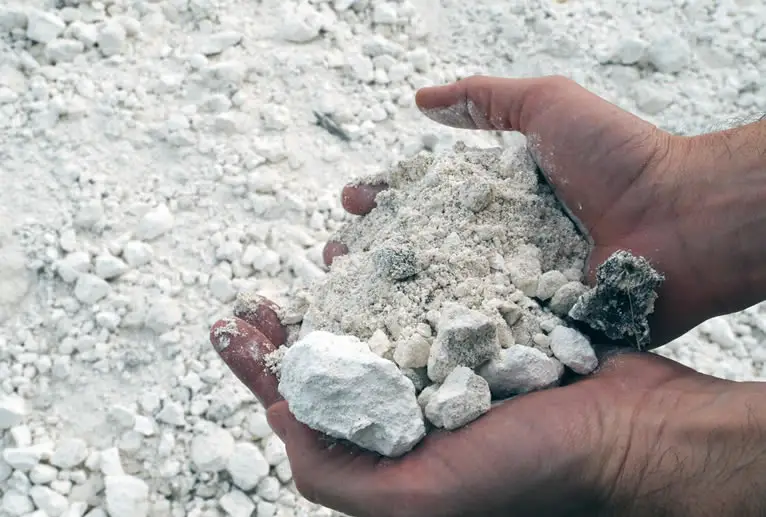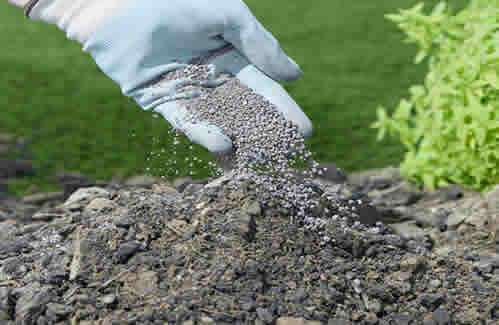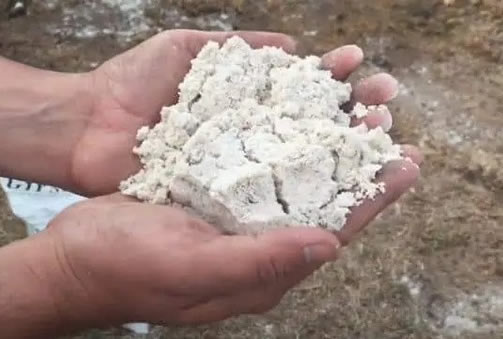The 2 Types Of Gypsum And How Long It Takes Them To Work

Gypsum is a very versatile mineral that is used in a wide range of items from building materials to digestible healthcare products. It has also been long used as a means of helping to improve improve aggregation, such breaking-up as compacted soil, and as a means of reducing salt in the soil. But, how long does it take gypsum to work?
Powdered gypsum will take several months, to several years, to effectively break-up compacted soil and reduce sodium levels. Certain types of liquid gypsum will start to work much sooner, sometimes in only days.
There are pros and cons to using each type of gypsum.
Table of Contents
How long does it take gypsum to work?
To some extent the length of time it takes gypsum to work will depend on the type of soil you are using it on.
If you are using gypsum mainly to break-up compacted soil it may take longer to work than it would to balance the level of salt in the soil.

Gypsum contains calcium sulfate which is a naturally occurring mineral. Because it is effective for helping to break-up compacted soil it is used mostly frequently on clay.
Although it is used as a way of reducing sodium in the soil because it is neutral it will not change the pH value of the soil.
Gypsum is mostly used on clay. Though, it is also very effective in areas where there is a hard compacted subsoil which has developed from heavy traffic over the ground from machinery, stock or people.
Be aware though that gypsum is not a miracle working solution that can break-up heavily compacted soil so you can avoid aerating the ground.
If the soil is very heavily impacted you will need to aerate the area as well as using gypsum.
Powered gypsum takes a long time to work but has some benefits over liquid gypsum.
A regular yearly application of gypsum will not only help avoid further soil compaction but it will greatly improve the soil and any crops growing in it.
The composition of the soil plays a role in the length of time it takes gypsum to work.
But, it is the type of gypsum you use that will have a greater effect on the length of time it takes for it to start to working.
Liquid gypsum works much faster than powdered gypsum but is considerably more expensive.
What is gypsum?
Gypsum is a very versatile mineral.
You may not be aware that it is put in a wide range of products, from concrete and building materials such as walls and ceilings to everyday items such as toothpaste.
But, as a fertilizer for the garden it can work wonders.
The 2 types of gypsum and how long they take to work
But what type of gypsum do you need and how long will each gypsum type take to work?
Powdered gypsum is slow working
Powdered gypsum is in plentiful supply and is a cheap way to help deal with high sodium levels in the soil and to break up clay or compacted subsoil.
A sustained yearly application of powdered gypsum will have a huge positive impact on the soil.
After about three years the soil will be in much better shape and any crops growing in it will be healthier and more bountiful.
Powdered gypsum does take a fairly long time to have any real meaningful effect though.
It takes several months, and in extreme cases several years, for powdered gypsum to do its work.
Positives of powdered gypsum:
- It’s cheap.
- It’s easy to apply.
- Prolonged use, over several years, has a major positive impact on the soil.
- It can help crops grow better.
Negatives of powdered gypsum:
- It takes several months to work.
- In extreme cases it can take several years to work.
Liquid gypsum works much faster
Liquid gypsum is a much faster working product compared to its powdered counterpart.
Where powdered gypsum will take several months to have an effect, liquid gypsum will work in a matter of days.
In extreme cases where you have soil that requires several years of treatment with powdered gypsum to achieve the desired result.
Liquid gypsum, on the other hand will do the same job in months or even weeks.
Positive of liquid gypsum:
- It’s fast acting.
- It’s easy to apply.
Negatives of liquid gypsum:
- It’s expensive.
How much gypsum you should add to soil
Gypsum is calcium carbonate which is neutral so it will not affect the pH of the soil, unlike lime which is often used instead.
Gypsum is also 200 times more soluble than lime and easier to use. But how much should you use?
- If you plan to use the soil for growing vegetables or garden plants then you should mix 20 – 30lbs of powdered gypsum per 1,000 square feet of ground.
- If there are already crops growing in the area where you wish to apply the gypsum use 40lbs per 1,000 square feet.
- If you are using liquid gypsum follow the instructions on the container.
As not all liquid products will have the same gypsum strength value it would be unwise for me to give you specific mixing instructions for applying liquid gypsum.
How often you should apply gypsum
Now you know the pros and cons of powdered vs liquid gypsum you may be wondering how often you should use it.
Applying gypsum once per year is more than enough to see tangible positive results.
Although some gardeners will tell you that you can use gypsum several times per year, I strongly advise against this.

This advice is often given to lawn owners who will not suffer as much from multiple gypsum applications as cultivators of plants and vegetables.
If you are cultivating any types of crops, from vegetables to flowering garden plants, using too much gypsum can have a very negative effect on their growth.
Gypsum will have no effect at all on the pH value of the soil.
However, adding too much of it can result in the elimination of much needed nutrients such as iron, manganese and aluminum which plants need for healthy growth.
Applying gypsum once per year is more than enough. If you are overly concerned about compacted soil aerate the ground!
To ensure even a once-per-year application has no negative effect on growing plants, I use a gypsum based soil repairer mix. This mix has the type of nutrients added to it that gypsum naturally strips away.
For the best & fastest results use a hybrid gypsum approach
For best results it is a good idea to consider using both liquid and powdered gypsum, but at different times.
For fast results ensure the initial application of gypsum is in liquid form.
This way you will see benefits in the soil very quickly without having to wait several months.
Within days the liquid gypsum will have had a positive effect on the soil and in conjunction with aeration the soil should be in fairly good shape.
Then, for your yearly application, revert to a powdered form of gypsum.
At this point the soil will not need the fast acting results offered by a liquid solution.
By applying the gypsum in a powder form you will get all the positive long term benefits without the short-term financial pain of using liquid gypsum again.
Thanks for reading! I'm Michael — houseplant fanatic and your Pinterest plant guide.
Follow me on Pinterest for fresh updates 🌿



